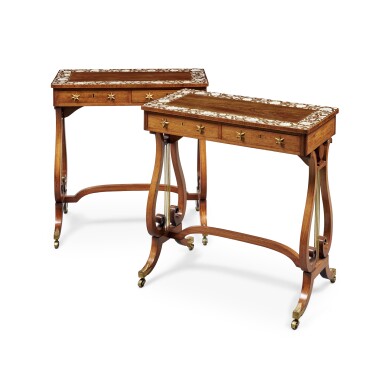The Vision of Aso O. Tavitian | The Townhouse
The Vision of Aso O. Tavitian | The Townhouse

A Pair of Regency Anglo-Indian Ivory-Inlaid Padouk and Rosewood Side Tables, the Tops Vizagapatam, Possibly 18th Century, the Table Frames First Quarter 19th Century
No reserve
Live auction begins on:
February 8, 03:00 PM GMT
Estimate
10,000 - 15,000 USD
Bid
1 USD
Lot Details
Description
each bearing a manuscript label to the underside Hon. Mrs Egerton's Trust
height 29 1/2 in.; width 29 in.; depth 14 1/2 in.
76 cm; 74 cm; 38 cm
Possibly acquired by Wilbraham Egerton (1781-1856), Tatton Park, Cheshire or his son William Tatton Egerton, 1st Baron Egerton (1806-1883);
Thence by descent to Alan de Tatton Egerton, 3rd Baron Egerton (1845-1920) and by descent to his wife The Right Honourable Anna Louisa Egerton (1843-1933) and sold by her trust;
Acquired by Captain Jack William Leslie Crawshay (1894-1950) and thence by descent to his wife The Honourable Mrs Harriette Crawshay who gifted them to an anonymous owner;
By whom sold Bonham's London, 24 June 2009, lot 101;
Where acquired by Aso. O Tavitian.
The port city of Vizagapatam (now known as Visakhapatnam in the modern state of Andhra Pradesh), on the Coromandel Coast of India north of Chennai, was a major trading city with the East India Company in the 18th century and developed a thriving specialised industry manufacturing both chintz fabrics and small boxes and case furniture in local teak and rosewood inlaid with engraved ivory decoration. In 1754 the British army officer Major John Corneille observed the city was famous for its textile production and 'likewise remarkable for its inlay work, and justly, for they do it to the greatest perfection' (cited in Amin Jaffer, Furniture from British India and Ceylon, London 2001, p.172). Originally the marquetry designs were derived from floral motifs based on chintz patterns, some of which were themselves inspired by English silk produced by Huguenot weavers in Spitalfields.
The composition of rectangular panels with inlaid floral spray borders seen on the Tavitian tables is found on several other recorded Vizagapatam works dating to the mid-18th century including a Kentian style cabinet on stand in the Victoria & Albert Museum (IS.289&A-1951), a kneehole desk or dressing table supplied to Clive of India now in Powis Castle, Wales, and a similar bureau formerly in the Marquesses of Townshend collection sold Sotheby's London, 21 January 2020, lot 175. Later in the century designs evolved from the dense floral elements limited to the border into surfaces entirely veneered in ivory engraved with architectural, figural and landscape scenes.
The lyre-shaped supports and star handles of this pair of tables are typical of early 19th century Regency furniture design, and its provenance from a 20th-century descendant of the Egerton family suggests a potential attribution to Gillows of Lancaster and London. The Egertons were one of the one most important clients of the firm, who supplied their residences in London, Heaton Hall and particularly Tatton Park (National Trust), which was remodelled for William Egerton and his son Wilbraham between 1780 and 1808 by the architects Samuel and Lewis Wyatt and still retains over one hundred fifty pieces of Gillows furniture original to the house. Gillows is known to have produced tables of this form, notably a pair commissioned by Thomas Anson, 1st Viscount Anson (1767-1818) for the library at Shugborough, Staffordshire. It is possible Gillows created the present tables using new or existing tops either specially commissioned from an Indian workshop or originally used or conceived as panels for another case piece.
You May Also Like










